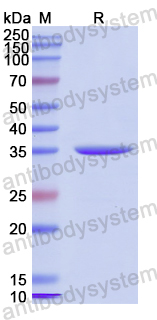Catalog No.
YHJ03501
Expression system
E. coli
Species
Homo sapiens (Human)
Protein length
Arg41-Leu335
Predicted molecular weight
35.76 kDa
Nature
Recombinant
Endotoxin level
Please contact with the lab for this information.
Purity
>90% as determined by SDS-PAGE.
Accession
Q5VT66
Applications
ELISA, Immunogen, SDS-PAGE, WB, Bioactivity testing in progress
Form
Lyophilized
Storage buffer
Lyophilized from a solution in PBS pH 7.4, 0.02% NLS, 1mM EDTA, 4% Trehalose, 1% Mannitol.
Reconstitution
Reconstitute in sterile water for a stock solution. A copy of datasheet will be provided with the products, please refer to it for details.
Shipping
In general, proteins are provided as lyophilized powder/frozen liquid. They are shipped out with dry ice/blue ice unless customers require otherwise.
Stability and Storage
Use a manual defrost freezer and avoid repeated freeze thaw cycles. Store at 2 to 8°C for frequent use. Store at -20 to -80°C for twelve months from the date of receipt.
Alternative Names
MTARC1, Molybdenum cofactor sulfurase C-terminal domain-containing protein 1, Mitochondrial amidoxime-reducing component 1, MARC1, mARC1, Moco sulfurase C-terminal domain-containing protein 1, MOSC1, MOSC domain-containing protein 1
Deep Learning Reveals Liver MRI Features Associated With PNPLA3 I148M in Steatotic Liver Disease., PMID:40478199
VLDL lipidomics reveals hepatocellular lipidome changes in metabolic dysfunction-associated steatotic liver disease., PMID:40408305
Gene-based therapies for steatotic liver disease., PMID:40254880
Second-Coordination-Sphere Effects Reveal Electronic Structure Differences between the Mitochondrial Amidoxime Reducing Component and Sulfite Oxidase., PMID:39350518
Biochemical and functional characterization of the p.A165T missense variant of mitochondrial amidoxime-reducing component 1., PMID:38723751
Liver-specific mitochondrial amidoxime-reducing component 1 (Mtarc1) knockdown protects the liver from diet-induced MASH in multiple mouse models., PMID:38696369
mARC1 in MASLD: Modulation of lipid accumulation in human hepatocytes and adipocytes., PMID:38619429
Divergent role of Mitochondrial Amidoxime Reducing Component 1 (MARC1) in human and mouse., PMID:38437227
Mitochondrial amidoxime-reducing component 1 p.Ala165Thr increases protein degradation mediated by the proteasome., PMID:38375985
Fatty liver disease protective MTARC1 p.A165T variant reduces the protein stability of MTARC1., PMID:38340654
Evaluation of Human Hepatocyte Drug Metabolism Carrying High-Risk or Protection-Associated Liver Disease Genetic Variants., PMID:37686209
MTARC1 and HSD17B13 Variants Have Protective Effects on Non-Alcoholic Fatty Liver Disease in Patients Undergoing Bariatric Surgery., PMID:36555467
Multiomics study of nonalcoholic fatty liver disease., PMID:36280732
Comprehensive analysis of tissue proteomics in patients with papillary thyroid microcarcinoma uncovers the underlying mechanism of lymph node metastasis and its significant sex disparities., PMID:36106120
Letter to the editor: The clinically relevant MTARC1 p.Ala165Thr variant impacts neither the fold nor active site architecture of the human mARC1 protein., PMID:35560545
Variants in mitochondrial amidoxime reducing component 1 and hydroxysteroid 17-beta dehydrogenase 13 reduce severity of nonalcoholic fatty liver disease in children and suppress fibrotic pathways through distinct mechanisms., PMID:35411667
MARC1 p.A165T variant is associated with decreased markers of liver injury and enhanced antioxidant capacity in autoimmune hepatitis., PMID:34949757
A genome-first approach to mortality and metabolic phenotypes in MTARC1 p.Ala165Thr (rs2642438) heterozygotes and homozygotes., PMID:34258604
Genome-Wide Association Study for Alcohol-Related Cirrhosis Identifies Risk Loci in MARC1 and HNRNPUL1., PMID:32561361
A missense variant in Mitochondrial Amidoxime Reducing Component 1 gene and protection against liver disease., PMID:32282858
Crystal structure of human mARC1 reveals its exceptional position among eukaryotic molybdenum enzymes., PMID:30397129
T4 lysozyme-facilitated crystallization of the human molybdenum cofactor-dependent enzyme mARC., PMID:29870017
Detoxification of Trimethylamine N-Oxide by the Mitochondrial Amidoxime Reducing Component mARC., PMID:29856598
Reduction of sulfamethoxazole hydroxylamine (SMX-HA) by the mitochondrial amidoxime reducing component (mARC)., PMID:25170804
Nitrite reductase and nitric-oxide synthase activity of the mitochondrial molybdopterin enzymes mARC1 and mARC2., PMID:24500710
Functional characterization of protein variants encoded by nonsynonymous single nucleotide polymorphisms in MARC1 and MARC2 in healthy Caucasians., PMID:24423752
Activation of the anti-cancer agent upamostat by the mARC enzyme system., PMID:23379481
The mitochondrial amidoxime-reducing component (mARC1) is a novel signal-anchored protein of the outer mitochondrial membrane., PMID:23086957
The mitochondrial Amidoxime Reducing Component (mARC) is involved in detoxification of N-hydroxylated base analogues., PMID:22924387
The fourth mammalian molybdenum enzyme mARC: current state of research., PMID:21942410
Reduction of N(ω)-hydroxy-L-arginine by the mitochondrial amidoxime reducing component (mARC)., PMID:21029045
Biochemical and spectroscopic characterization of the human mitochondrial amidoxime reducing components hmARC-1 and hmARC-2 suggests the existence of a new molybdenum enzyme family in eukaryotes., PMID:20861021
Reduction of N-hydroxy-sulfonamides, including N-hydroxy-valdecoxib, by the molybdenum-containing enzyme mARC., PMID:20699408

